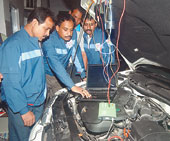 |
The times, they are a-changing...I remember when I used to work in a reputed private garage in Calcutta. That was when I came across a number of unusual yet fascinating words, which passed as automotive terminology in mechanics? lingo. I don?t remember most of them now but the ones that have really stayed with me are ?bandook? and ?cutting shaft?. The first is a Y-shaped bracket used to keep exhaust pipes in place; the second, a corruption of Cardan shaft (the propeller shaft). Then there was ?churi? and ?jumping? (dampers) and specific to the Ambassador, ?pistoal?, ?potol? and even ?chocolate?.
Today, of course, there has been a sea change with the proliferation of dealers and official workshops where instead of the driver taking the car to the garage for repairs, owners take them in themselves. This, of course, is largely due to the increase in self-driven vehicles and the increased cost of employing a chauffeur these days.
Even so, a lot of owners have difficulty understanding the jargon that?s thrown at them and most come away believing he or she has left his or her pride and joy in safe hands. What follows is a ready guide for modern-day car owners who?d like to take more interest in their cars, a simple explanation of car terms and terminology.
Let?s start at what is the most interesting part of the car, at least for me: the engine. It comprises two basic parts ? a cylinder block, which is a metal casting with cylinders where the combustion of the air-fuel mixture takes place, pistons, the camshaft (in some engines), the crankshaft and oil pump.
The second part, the cylinder head, which sits on top of the block, contains the valve actuating mechanism, spark plugs and the inlet and exhaust manifolds. Basically, a car engine takes in vapourised fuel and burns it to release energy. This energy is used to push a piston down with great force. The bottom end of the piston is attached to a shaft called the crankshaft.
 |
The downward action of the piston forces the crankshaft to revolve and this revolving action (torque) is transmitted to the rear wheels via a propeller shaft in rear-wheel-drive cars (like the Ambassador) or via shorter half-shafts to the front wheels of a front-wheel-drive car (like the Maruti 800, the Alto and the Zen). In fact, torque is the ability of an engine to twist the crankshaft around, thereby imparting motion to it and finally, the road wheels via the transmission. This is what a car?s initial acceleration depends upon.
A present-day car engine employs the Otto or Carnot cycle depending on whether it runs on petrol or diesel. This is a four-stroke cycle in which the fuel is ignited once every two revolutions of the crankshaft. The stroke refers to the distance the piston travels in the cylinder. The four strokes are induction, where the piston moves downward to create a partial vacuum, air-fuel mixture is sucked into the cylinders; followed by compression where the piston moves up to compress the mixture.
Next comes ignition (or power) where due to high pressure, when the spark ignites the mixture, it burns so rapidly that it explodes. The energy released forces the piston down at great speed, forcing the crankshaft to revolve. The fourth and final stroke is exhaust, where the piston having spent its energy, returns to the top of the cylinder while pushing out the burnt gases.
Older cars like the Premier Padmini and the old Ikon 1.3 had OHV (overhead valve) engine where valves were in the head over the camshaft located in the block and the valves were actuated by the camshaft via pushrods. Modern engines are of the OHC (overhead cam) type where the camshaft is located over the head and actuates the valves directly. The latter has the advantage of having a lesser number of moving parts and so the overall loss of energy via friction is greatly reduced.
Engines need lubrication and the conventional method is to have a reservoir of oil below the block, which lubricates and cools the moving parts of the engine. Engines are classified as inline, boxer (or horizontally opposed) or vee. This refers to the way the engine?s cylinders are laid out. Most cars running on Indian roads have inline units. The Sonata V6, Skoda Superb and the Honda Accord V6 have vee engines like the Formula 1 cars. The VW Beetles once seen on Indian roads used to have boxer engines where the cylinders are not upright or angled but flat, so the pistons seem to move opposite to each other.
All said and done, technology has taken us far in terms of advancements in power development, tractability and pollution control. But at the end of it all, engines still run on the same principle of fuel going in, mixing with air before being burnt and then being exhausted into the atmosphere. There really is nothing that complicated about car engines ? blame the advertising chaps out there for most of the confusion.
Easy listening
 |
Tanmoy Bose
Musician
I love listening to music in the car and although there?s quite a stack of CDs in there, my current favourites are Pat Matheny and Peter Gabriel. Both are widely acclaimed in the world music genre and Matheny?s album, Ancient World, is wonderful. His sound is a fusion of rock and roll, the Jimi Hendrix style and a lot of sound bytes. One of his tracks that I particularly love is Sounds of Amazon, which is at once contemporary and primitive ? further heightened by sounds like that of a waterfall. All in all, Matheny?s type of music is energetic and cerebral, which is what appeals to me especially since I am working on a project along the same lines. In fact, I have just recorded a Brazilian track called Drum Dream in Berlin and so the demo CD is also something that I am listening to a lot nowadays. But besides these, my age-old favourites, Lata Mangeshkar and Kishore Kumar are regulars when I?m in the car.
As told to Janine Wynne-Peters










